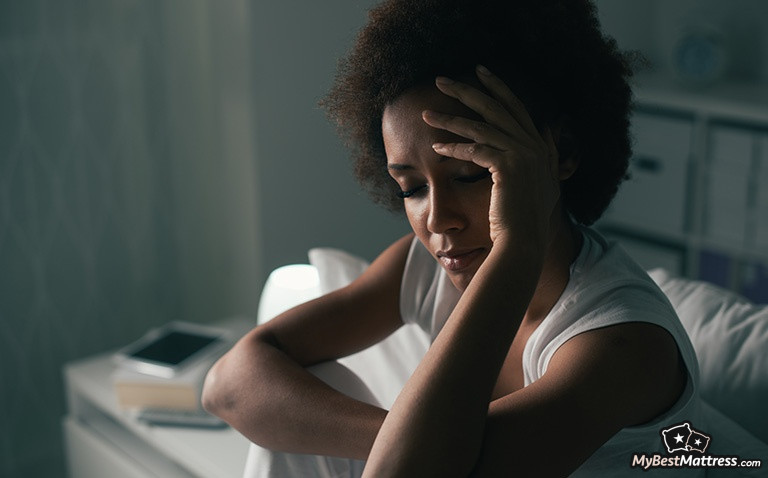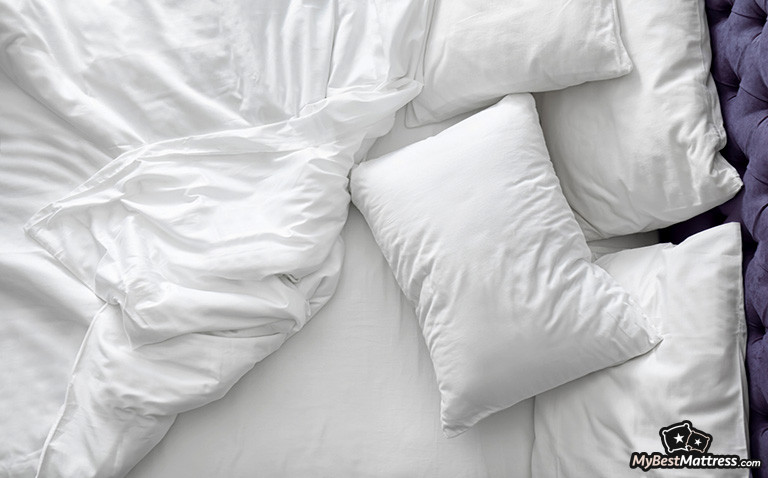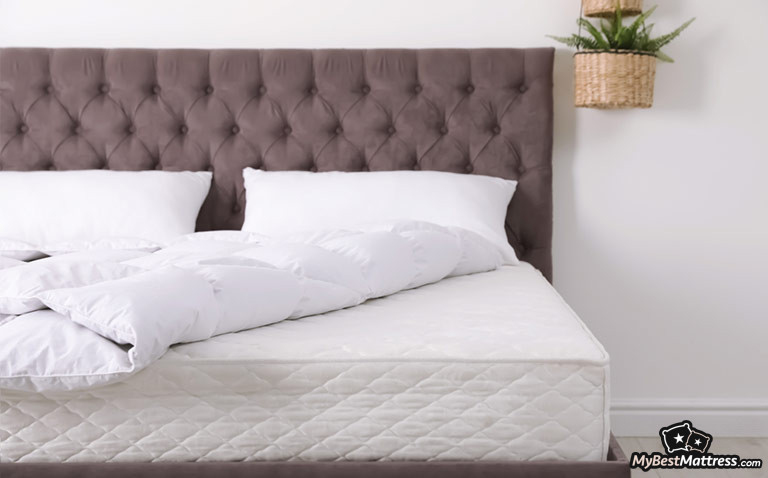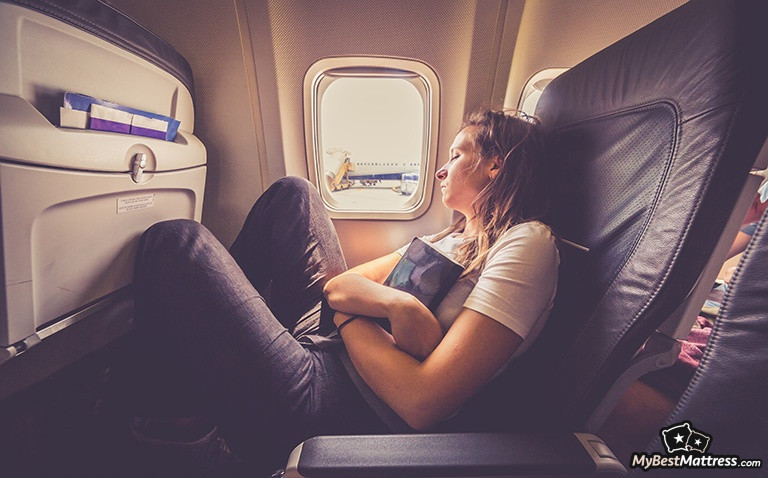
Everyone would like to be able to skip those long international flights by just drifting off to sleep and feeling refreshed and ready for the world once landed. Well, it’s not always that easy. Because with turbulence, uncomfortable seats, and a big likelihood of a baby crying behind you, many find it hard to figure out exactly how to sleep on a plane.
Whether it’s your first or one-hundred-and-first flight, sleeping through the chaotic trip sounds much more appealing than being aware of the 6 or more hours in a cramped seat next to an armrest-hogging stranger. Well, it’s sad to say, but unless you’re in first-class or can pass out absolutely anywhere, you might need to pull out a lot of stops to get some high-quality sleep.
So, what should you bring on your trip, and are there any contortion exercises you might need to do before your departure? Here are some tips on how to sleep on a plane that will make your next flight much more bearable.
Table of Contents
- 1. Why Is It So Hard To Sleep On Planes?
- 2. Is Sleeping On A Plane Safe?
- 3. The Science Behind Jet Lag
- 4. How To Sleep On A Plane - Tips, Tricks, And Essentials
- 5. Best Pillows To Banish Neck Pain
- 5.1. Saatva - A Graphite-Infused Memory Foam Pillow
- 5.2. Layla - Best for Side Sleepers
- 5.3. Purple - Unique Pillow Filling Technology
- 6. Conclusions
Why Is It So Hard To Sleep On Planes?
There is a reason so many of us wonder how to sleep on a plane. I’m sure there are very few people who have no trouble with it.
Even at a first glance, airplanes don’t come across as the ideal sleeping spot. Crowded, loud, and often very shaky - the perfect recipe for a refreshing nap, right? And if it’s your first time flying, chances are your nerves could keep your eyes wide open even in the comfiest bed!
However, there are other nuances that can contribute to your international insomnia.
First of all, let’s get the obvious reasons out of the way. Noone would be able to sleep peacefully in a confined, stuffy seat, surrounded by various noises and movements that keep distracting you.
That being said, there are other factors at play that prevent you from fast-forwarding your extra-long trip.
Believe it or not, but people aren’t exactly built for hurling through the sky in a giant metal contraption at speeds 550 miles per hour and as high as 7 miles above sea level.
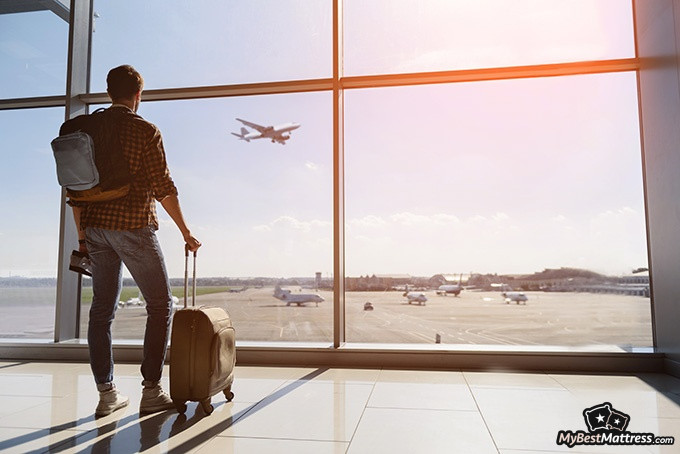
In fact, the altitude at which airplanes fly is one of the main reasons that make sleeping on a plane almost impossible to some.
Humans function best at sea level, where oxygen levels are at 20.9% and the atmospheric pressure stays at around 101,325 Pa. This is our ideal environment and as we go higher while in a plane - very quickly might I add - we leave our comfort zone far behind.
At the average heights where planes fly, oxygen levels and atmospheric pressure are more than three times lower than we are accustomed to, shocking our bodies and causing notable discomfort.
We are all familiar with the ringing in our ears during takeoff and landing. This is caused by decreased pressure affecting our inner ears, which, along with the rest of our bodies, require time to acclimate to the sudden changes.
When it comes to the decrease of oxygen, the main keyword to remember is “moderation”. As we fall asleep in regular, non-flying conditions, oxygen levels in our bodies lower[1] on their own. That’s why we yawn when we are sleepy - more oxygen keeps us alert.
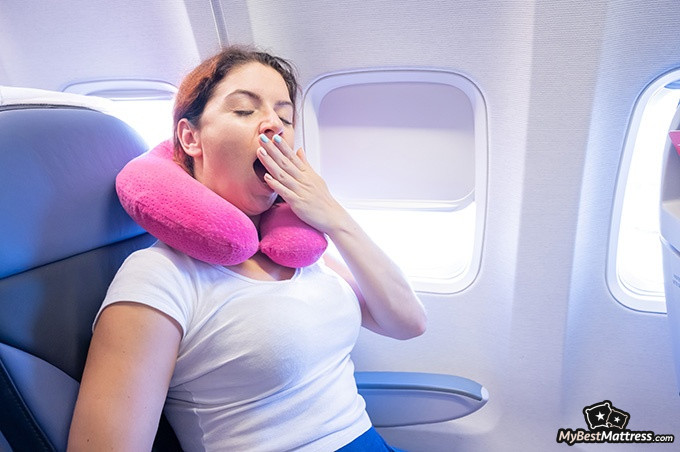
However, a rapidly dropping oxygen level can cause more harm than good. Studies[2] have shown that lack of oxygen during sleep can cause a plethora of problems, such as headaches, restless sleep, rapid breathing, and even elevated blood pressure.
These external factors are impossible to control, as you would simply be fighting against physics. So if you want to know how to sleep on a plane, you will need to look for other hacks.
In addition, humans are simply not designed to sleep while sitting upright. Mostly because several times throughout the sleep cycle we lose control over our bodies and become completely paralyzed.
During the first 60 - 90 minutes of us falling asleep our bodies slowly sink into a deep sleep. This is when our bodies still have some muscle tone left, even though we are slowly relaxing more and more. However, once REM sleep sets in, our bodies completely relax, and that comfortable position you took 10 minutes to find is as good as gone.
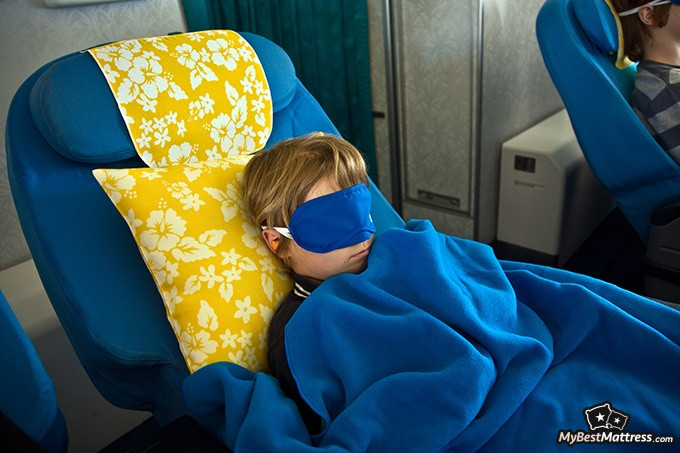
Of course, I have to admit, that if you settle in just right, you might avoid suddenly jolting up from your head falling to one side or the other. But in most cases, you will most likely bump into either your next seat neighbor, the cold plexiglass window, or someone passing your seat in the aisle.
In any case, having a nice nap throughout your flight is pretty much impossible. In addition, because of the incomplete sleep cycle, you will most likely feel even more groggy than before dozing off!
And yet, with biology and even physics working against us, we are still searching for how to sleep on a plane. But have we ever stopped to think if we should be sleeping on a plane?
Is Sleeping On A Plane Safe?
More often than not, those who wonder how to sleep on a plane would like to fast forward an often scary situation. I’m one of those people, so I completely understand that flying isn’t everyone’s favorite experience.
But have you ever thought about how not to fall asleep on a plane?
Truth be told, you might not want to fall asleep as soon as you find your assigned seat. Not to freak you out anymore, but sleeping on planes during takeoff and landing can actually be dangerous.
Now, don’t worry. You didn’t doom the entire flight to crash and burn just because you fell asleep before the plane took flight. In fact, you would be affected the most by sleeping on a plane while taking off and landing.
We’ve already established that air pressure in the plane rapidly changes during the first and last 10 minutes of the flight - that’s usually how long it takes for commercial jets to reach their cruising altitude.
And because we are in the cabin during takeoff and landing - at least I hope that’s where you are - we are inevitably affected[3] by the decrease of air pressure, inside and out.
Most notably, our ears feel blocked and the world sounds dull until the eardrums finally “pop” while taking off. This is a result of our bodies naturally regulating the air pressure on our eardrums, as not doing so could damage them.
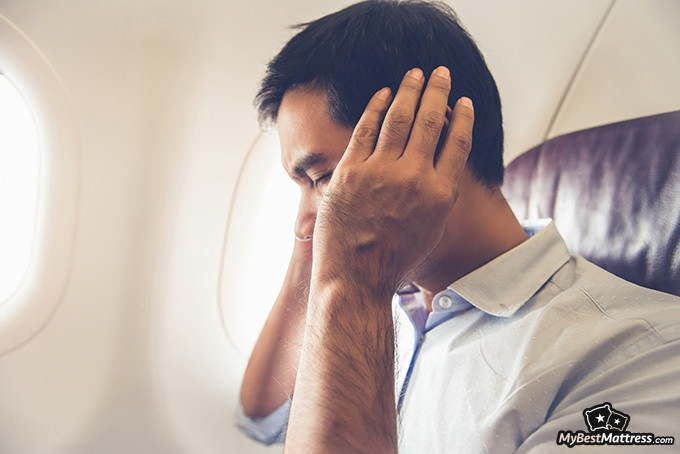
Do you see where I’m going with this?
If you are asleep while the air pressure is quickly decreasing, your body cannot manually relax the ear muscles to keep your eardrums safe.
If you do end up falling asleep before you’re in the sky, you might end up feeling dizzy after waking up at best and end up with nosebleeds, ear infections, or even permanent hearing damage at worst.
Thankfully, there are ways to make the takeoff and landing process as smooth and painless as possible. Your best bets are alleviating the pressure in your ears by either yawning - perfect if you’re trying to fight off sleep - or frequently swallowing. If you decide to go for the second option, you can either sip on some water, chew gum, or suck on hard candy.
This will not only regulate the pressure between the inside of your ears and the cabin pressure but distract you just enough to keep you awake during the first and last moments of the flight.
Two birds with one stone, right?
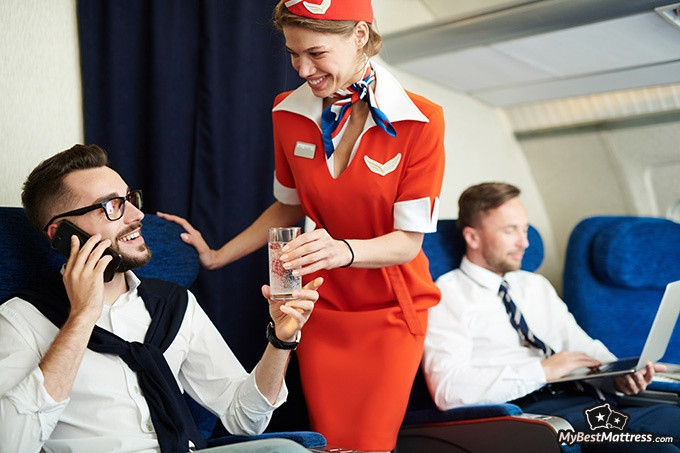
With all that in mind, there aren’t many other side effects of sleeping on planes. In fact, knowing how to sleep on a plane can help you avoid flying sickness and even help you fight off the dreaded jet lag.
The Science Behind Jet Lag
Whether you’ve experienced it yourself or heard your favorite celebrity complaining about it online, jet lag is almost inevitable while traveling with planes.
Simply put, jet lag is when your internal clock, known as your circadian rhythm, does not match up with the local day-night time. Even though it sounds quite insignificant and more like an inconvenience than anything else, jet lag is actually considered to be a sleep disorder with notable effects on the body.
Among generally being out of sync with the local time, jet lag can have additional symptoms that aren’t mentioned as often as they should be, such as:
- Dizziness and fatigue;
- Worse physical performance - this is most often noted by traveling athletes;
- A general feeling of being unwell, such as a headache or body aches;
- Stomach and gastrointestinal problems, starting with nausea and ending with constipation or even diarrhea;
- In rare cases, people have reported experiencing jet lag induced sleep paralysis and even seizures.
These unpleasantries are caused by our hormone production being thrown off course by the change in our sleep patterns. As we try to adapt to a different rhythm, our melatonin production slowly adjusts with us, resulting in temporary ailments.
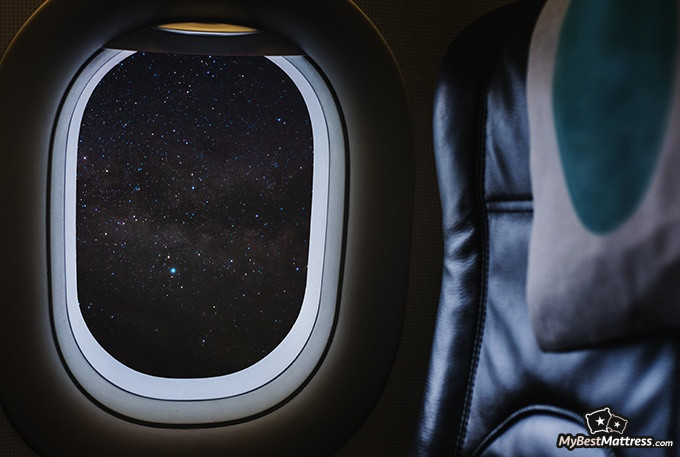
Generally, the more timezones we cross while traveling the worse and more persistent the side effects are, taking around 1-1.5 days to go away for every time zone crossed.
Speaking about time zones, you can estimate how much you will be affected by jet lag by the direction of your trip. In general, jet lag can set in after as little as 3 time zones skipped and only worsen with every additional one. To add to that, people are much more affected by jet lag if they travel east rather than west.
If you like to - and are able to - sleep on planes, I have good news for you! Sleeping on a plane can actually help reduce the effects of jet lag. This is especially useful if it’s nighttime at your destination at the time of your flight - this will help make the adjustment to the new time much less uncomfortable.
Of course, there are other ways to alleviate jet lag symptoms. Making sure you’re well-hydrated and rested all throughout your trip is the most surefire way of quickly adjusting to the new sleep-wake pattern.
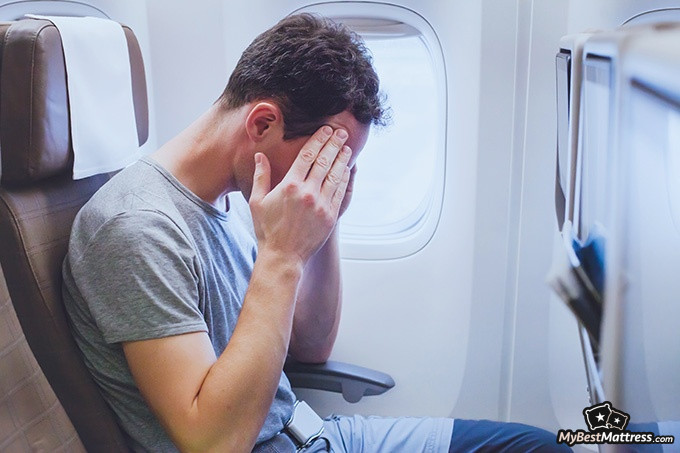
But if you decide to sleep through the flight, here is everything you need to know about how to sleep on a plane.
How To Sleep On A Plane - Tips, Tricks, And Essentials
Alright. You have your vacation planned out, you are buzzing with excitement, and are ready to take the trip of your lifetime. But as you’re getting ready you start wondering what you should do to help you sleep on the plane. Do you have the right seat? Should you bring a pillow? What about a weighted blanket? Maybe you should grab your diffuser, just in case…
Relax, breathe, and don’t worry.
Here’s exactly what you could need to snooze through your entire flight:
- First and foremost, seating plays a more important role than you might think. Dare I say, it can be the determining factor when it comes to actually sleeping on the plane. Window seats remain the undefeated champions when it comes to the best spots on a plane. This is not just because of the incredible views - having several surfaces to lean against is arguably the best way to sleep on a plane. Plus, having something to lean against that won’t make you feel awkward once you wake up is always a perk. In addition, if your row is full, your seat neighbors won’t have to climb over you to go to the bathroom and potentially wake you up. If possible, try to avoid bulkhead or exit row seats, as they usually don’t recline due to safety and have non-raisable armrests. But it is possible to make them work, even if sitting upright is not the best way to sleep on a plane.
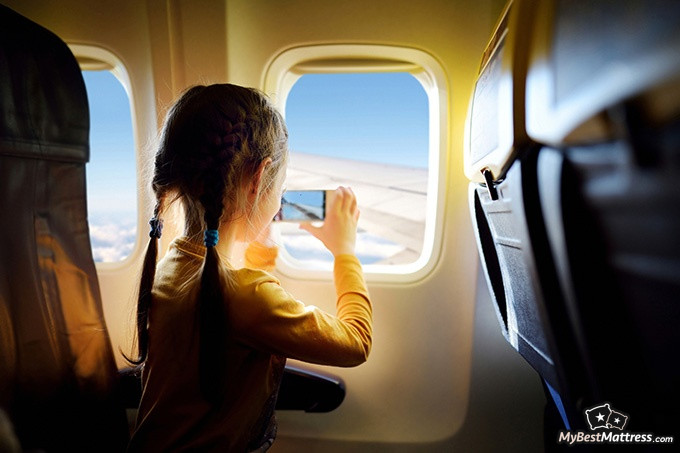
- As difficult as it may be to resist, especially if you’re catching a flight before the sun is even up, but skipping caffeine before liftoff can actually change your entire sleeping on a plane experience. Of course, to most, it might be a no-brainer. But if making a good ol’ cup of Joe in the morning is second nature to you, leaving this part of your routine out for that one morning could do you more good than harm.
- We, humans, are interesting creatures. We need a very specific temperature to be able to have the best sleep of our lives - between 60 and 67 degrees Fahrenheit. And truth be told, the temperature inside a plane does reach that golden number while in the air! … several times that is. In most aircrafts temperatures can fluctuate by as much as 50 degrees throughout the flight, making sleep much more difficult than it should be. The best way to avoid overheating or catching a chill during your nap is dressing in light layers that can be easily added on or taken off to assure an optimal sleeping environment.
- Now, I might be the only person that actually feels sleepier when the light is on rather than off. But if you are part of the majority that need darkness to doze off, bright lighting down the aisle can throw your melatonin production out of sync. If you are in a window seat, you can control the amount of lighting a little bit by closing the blinds, however, extra precautions could still be needed. A sleep mask can help signal your body to produce melatonin at the preferred time and help keep you asleep throughout the flight. If you are looking for a high-quality sleep mask, you can always trust Bedtime Bliss or Alaska Bear. Believe me, when I say, it will feel like your eyes are being hugged!
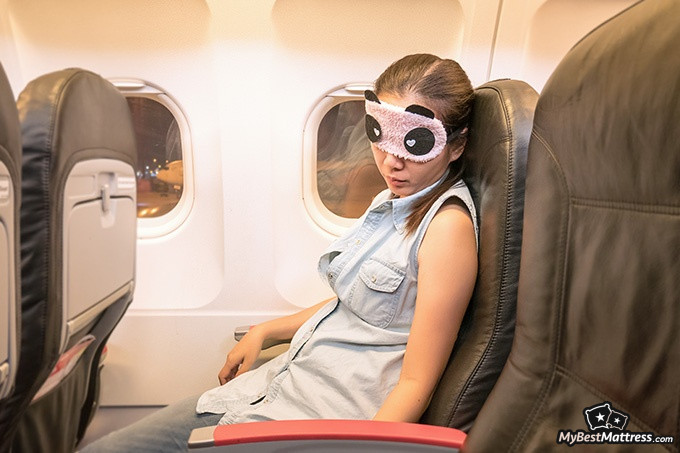
- Of course, fluorescent lights and popping ears aren’t the only things keeping you from having sweet dreams while in the sky. There’s no denying that planes are not the most tranquil, making it notably difficult to get some shuteye. Well, there are a couple of options that you can choose from to help keep out the noise. Firstly, you could go the old-fashioned route and get yourself a pair of noise-canceling earplugs. Alternatively, you could switch out one noise for the other. Studies[4] have found that pink noise is actually better for falling asleep than white noise. So trade in your favorite playlist for some ocean or wind sounds and a new set of headphones and let yourself drift off to dreamland.
- All of these things are necessary to assure that you get some sleep during your flight. However, everyone knows that the best way to sleep on a plane requires one simple accessory - the all-mighty neck pillow. Of course, you might not need one if you’re flying in first class, with all the accommodations and enough legroom to host a small dance party. However, for everyone else in economy class, neck pillows can truly be the ultimate saving grace. One thing is for sure - jolting from sleep because your head is falling is not a pleasant experience for anyone. A good neck pillow will not only offer you comfort and support, but it will also help you avoid neck pain in the future, making your vacation much more enjoyable.
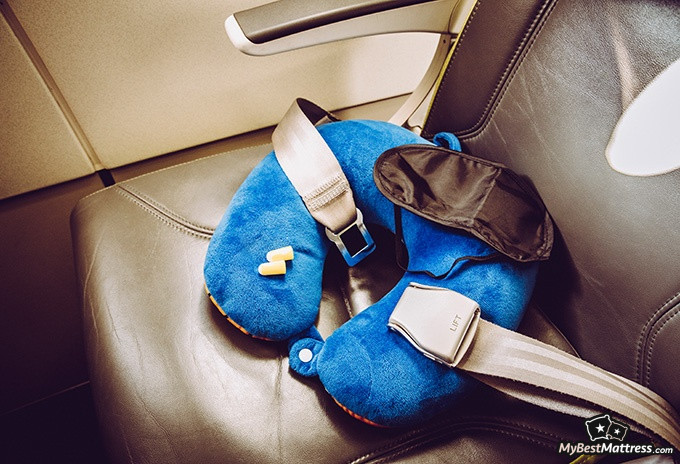
- If all else fails and you still spend the majority of your flight awake in your seat even with earplugs, eye-masks, and neck pillows, wondering how to fall asleep on a plane, you might want to look for the answer over the counter. Melatonin and Tylenol are the most common and readily available options, helping you fall asleep much quicker and stay asleep longer. Though abusing them is not recommended, taking them before long flights is perfectly fine, as it can help adjust to new time zones, avoiding jet lag! Of course, sleeping pills are only an answer to "how to fall asleep on a plane?", so additional preparation might be needed to assure you stay asleep.
If you are curious about how to sleep on a plane then you might be disappointed that you need more preparation and accessories than some might want to bring with them in their carry-ons. Admittedly, sleeping on a plane has never been and never will be easy. Therefore, you need to make sure that you are maximizing your chances of a good snooze yourself.
However, once your trip is over, you might find yourself with more or less neck pain - sometimes even a neck pillow won't be able to save you from over 6 hours in an uncomfortably contorted position, just so you would not disturb your neighbors in the next seat.
So, where should you look for support *wink wink* after sleeping on a plane?
Best Pillows To Banish Neck Pain
Whether you travel a lot, you got really unlucky and your neck pillow didn’t offer you proper support during your last trip, or you simply suffer from a chronically sore neck, one of the most important and effective steps you can take is choosing a pillow that is designed to alleviate neck pain.
After all, even though no one likes sleeping on planes, everyone enjoys sleeping on a great pillow!
A pillow created to help with neck pain can be especially useful if you want to know how to sleep on a plane without much discomfort or often travel with overlays and have to sleep in not the most comfortable positions.
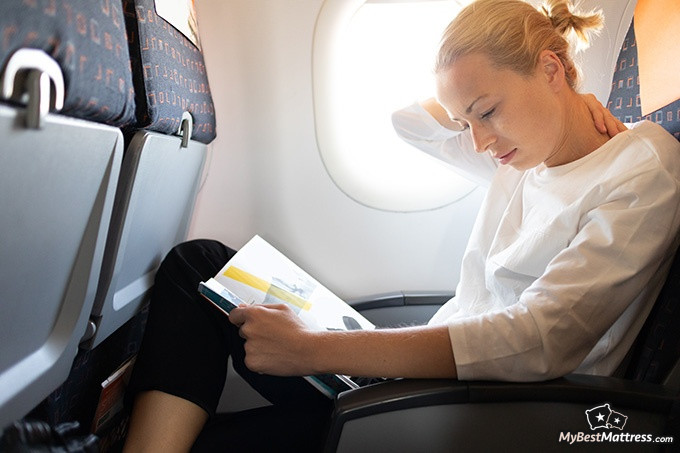
Neck, shoulder, back, and hip pain is one of the most common health issues among people today, as the majority of the population works office jobs that involve a lot of sitting, hunching, and generally bad posture. Not to mention the growing popularity of traveling via planes, meaning many people can't get away from a sore neck.
However, never fear! As there are several high-quality pillows to choose from designs specifically to help fight off neck pain.
Saatva - A Graphite-Infused Memory Foam Pillow
First and foremost, Saatva remains the undefeated champion. Their graphite-infused memory foam pillow is designed to perfectly mold around your head and neck to provide support for your entire spine, no matter the position you like to sleep in.
If materials used are an important deciding factor to you, rest assured, as not many pillows use such high-quality organic cotton and 100% CertiPUR-US memory foam. In addition, the pillow is infused with cooling gel, allowing your body to stay at an optimal temperature while you sleep.
Latest Saatva Coupon Found:
UP TO $500 OFF
Limited-time Saatva Sale
We're sharing a limited-time Saatva mattress discount with our readers! Grab this deal & enjoy your new mattress with huge discounts.
Layla - Best for Side Sleepers
If you’re a proud side sleeper, you might be interested in pillows designed specifically with you in mind. One such example - the Layla pillow. One thing that has this pillow stand out is just how soft it is. No wonder - it’s stuffed with a mixture of shredded memory foam and kupak tree fibers.
With this pillow, you can forget uncomfortable pressure on your neck at night, as it truly feels like sleeping on a cloud! In fact, if you would like to bring your pillow on board with you but don’t know exactly how to sleep on a plane with a regular pillow, worry not - Layla will make sure you sleep like a baby all throughout the flight.

Did you know?
Have you ever wondered which mattresses are approved as the best for sleep?
See & compare TOP mattresses side by sidePurple - Unique Pillow Filling Technology
Memory foam, fiber filling… These are all familiar and recommended by many pillow variations. That being said, some people are looking to try something new. Some pizzazz, if you will. Well, the Purple Pillow is as innovative as they come, using their trademarked Smart Comfort Grid technology, also featured in their best-seller mattresses.
As mentioned previously, the temperature is very important for high-quality sleep after a long flight home from your vacation. Well, you can forget flipping your pillow over several times during the night just to get to the cool side, because Purple is designed to keep you from overheating all throughout the night, no matter the weather or time of year.
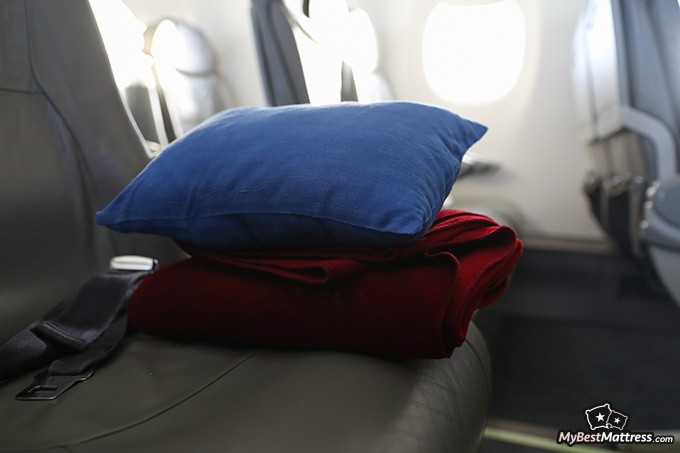
High-quality pillows are important to everyone, but especially to those who spend a significant amount of time in the sky. Neck pain can creep up on you seemingly out of nowhere, and sometimes your neck pillow could use some backup back home.
The three pillows mentioned above are the cream of the crop, but if you would like to see what other options are out there, you can always check out our list of the top pillows for neck pain.
Or, browse some of the best pillows currently available.
Conclusions
Wondering how to sleep on a plane pretty much comes with the territory of flying. Crammed spaces, uncomfortable seats that don’t always recline, and so many noises that eventually blend together all keep us from snoozing while in the sky.
That being said, there are many ways you can help yourself relax and drift off to la-la-land. From over-the-counter sleeping aids to traveling essentials such as neck pillows and earplugs, there really is something out there to fit everyone’s needs.
One such hack is preparing your body to sleep at the time of your flight by starting to slowly shift your sleep pattern before the trip. And of course, you can never forget your neck, tired from fighting gravity while you’re trying to figure out how to sleep on a plane.
Treat yourself to a high-quality pillow designed to alleviate neck pain and forget the weeks of aches and pains trying to recover from sleeping in a plane seat.
To sum everything up, cracking the code of how to sleep on a plane can take some time, but it is definitely possible. Just try to fight off Mr. Sandman for the first and last few minutes of your flight - your eardrums will surely thank you!
Thank you for flying through this article and we wish you sweet travels and pleasant dreams!
Scientific References
1. Thomas Ryan, Stanislaw Mlynczak, Tim Erickson, et al. 'Oxygen Consumption During Sleep: Influence of Sleep Stage and Time of Night.'
2. Sarkar M, Niranjan N, Banyal PK. 'Mechanisms of hypoxemia [published correction appears in Lung'
3. Eileen McNeely, John Spengler, Jean Watson 'Health Effects of Aircraft Cabin Pressure In Older and Vulnerable Passengers. Airliner Cabin Environment Research (ACER)'
4. Kawada T, Suzuki S. 'Sleep induction effects of steady 60 dB (A) pink noise.'
Leave your honest feedback
Leave your genuine opinion & help thousands of people to choose the best mattress. All feedback, either positive or negative, are accepted as long as they’re honest. We do not publish biased feedback or spam. So if you want to share your experience, opinion or give advice - the scene is yours!



